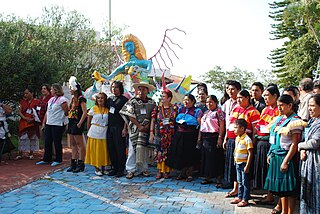
Mexico's culture emerged from the culture of the Spanish Empire and the preexisting indigenous cultures of Mexico. Mexican culture is described as the 'child' of both western and native American civilizations. Other minor influences include those from other regions of Europe, Africa and also Asia.

The music of Mexico is highly diverse, featuring a wide range of musical genres and performance styles. It has been influenced by a variety of cultures, primarily deriving from Europeans, Indigenous, and Africans. Music became an expression of Mexican nationalism starting in the nineteenth century.

Ana Lila Downs Sánchez is a Mexican singer-songwriter. She performs her own compositions and the works of others in multiple genres, as well as tapping into Mexican traditional and popular music. She also incorporates indigenous Mexican influences and has recorded songs in many indigenous languages such as Mixtec, Zapotec, Mayan, Nahuatl and Purépecha. Born and raised in Oaxaca, she primarily studied at the Institute of Arts by Oaxaca and briefly attended the University of Minnesota, before withdrawing to focus on her musical career. She soon began performing in the traditional music scene of Oaxaca City.

Alebrijes are brightly colored Mexican folk art sculptures of fantastical (fantasy/mythical) creatures.
Sonido 13 is a theory of microtonal music created by the Mexican composer Julián Carrillo around 1900 and described by Nicolas Slonimsky as "the field of sounds smaller than the twelve semitones of the tempered scale." Carrillo developed this theory in 1895 while he was experimenting with his violin. Though he became internationally recognized for his system of notation, it was never widely applied. His first composition in demonstration of his theories was Preludio a Colón (1922).

YuridiaValenzuela Canseco, known mononymously as Yuri, is a Mexican singer, actress, and television host.
Rodolfo Nieto Labastida was a Mexican painter of the Oaxacan School.
Cristina Eustace is a Mexican singer. She was also the winner of the fifth season of Objetivo Fama. This show was a Puerto Rican television singing talent contest in the form of a reality show, broadcast by Telefutura in the United States and by Univision Puerto Rico.

San Martín Tilcajete is a town and municipality located about 23 kilometres (14 mi) from the city of Oaxaca, in the state of Oaxaca, in the south of Mexico. It is part of the Ocotlán District in the south of the Valles Centrales Region

The Museo de Arte Popular is a museum in Mexico City, Mexico, that promotes and preserves part of the Mexican handcrafts and folk art. Located in the historic center of Mexico City in an old fire house, the museum has a collection which includes textiles, pottery, glass, piñatas, alebrijes, furniture and much more. However, the museum is best known as the sponsor of the yearly Noche de Alebrijes parade in which the fantastical creatures are constructed on a monumental scale and then paraded from the main plaza or Zocalo to the Angel of Independence monument, competing for prizes.

Susana Harp Iturribarria is a Mexican singer and politician. She currently serves as a senator representing the state of Oaxaca.

Georgina "Geo" Meneses is a Mexican producer and singer of traditional music and world music genre.

Ana Margarita Díaz Aceves, better known as Ana Diaz, is a Mexican composer and singer of contemporary Mexican songs. In her musical style, she mixes sounds like jazz, blues, bossa nova, ballad, pop, Latin music, cumbia and Mexican rhythms, which essentially makes her genre world music.

The Mexico City Alebrije Parade is an annual event to honor Mexican handcrafts and folk art, especially a hard kind of papier-mâché called “cartonería” and the creation of fantastic figures with it called “alebrijes.” Alebrijes are chimera-like creatures credited to artisan Pedro Linares painted in bright colors. The alebrijes for the parade are larger than anything Linares created, up to four meters in height and three meters in width. The parade begins on midday on a Saturday in late October in the historic center of Mexico City. The giant creatures are accompanied by musicians, clowns, people in costume and more, giving the event a Carnival-like atmosphere. After the parade the creations are judged with prizes awarded. There are also related literary and musical compositions.
Lorena Braga Gomes Simpson aka " Lorena Simpson" is a Brazilian singer, dancer, and songwriter born in Manaus, Amazonas. She is the biggest and most awarded Brazilian artist in the electronic music scene. She became well-known for hits such as "Brand New Day" and "Can't Stop Loving You”.
Events in the year 1997 in Mexico.
Events in the year 1991 in Mexico.

Feria Maestros del Arte is a non profit organization and annual three-day event held to support Mexican handcrafts and folk art in Chapala, Jalisco, Mexico. Unlike other fairs of this type, invited participants are not charged booth fees or percentages, and are even afforded transport and accommodations with area families. The Feria has grown from thirteen artisan participants to over eighty, and the organization is legally recognized in Mexico and the United States.
Alejandro Luis Madrid-González is an American music scholar, cultural theorist, and professor, whose research focuses on Latino and Latin American musics and sound practices. He is the Walter W. Naumburg Professor of Music at Harvard University.












